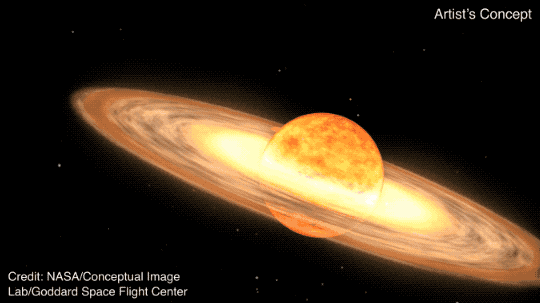Astronomy
Were Stonehenge's Builders Guided by the Moon?
Researchers are studying the monument's connection to a celestial event that occurs every 18.6 years
A Rare Nova Explosion Will Soon Bring a 'New Star' to the Night Sky—How to Catch a Glimpse
In an event that occurs only once every 80 years, a distant remnant of a star will grow much brighter, briefly becoming visible to Earth
A Stellar Collision Birthed the 'Dragon's Egg' Nebula, a Puzzling Structure in the Milky Way
The colorful cloud of gas and dust has a violent origin—and this explains the unusual traits of two massive stars within it, astronomers say
Astronomers Discover a 'Sleeping Giant' Black Hole in Our Galaxy—the Second-Closest Known to Earth
Called Gaia BH3, the dormant black hole is 33 times more massive than the sun, making it the largest recorded stellar black hole in the Milky Way
The Seven Most Amazing Discoveries We’ve Made by Exploring Mercury
Only two robotic missions have made it to the Swift Planet, but they were crucial for upending many false assumptions of that sun-scorched world
Meteorites Are Becoming Harder to Find as They Sink Into Antarctica's Melting Ice
The disappearing space rocks are burying valuable clues into the history and composition of our solar system, according to a new study
How to Watch the Brilliant Lyrid Meteor Shower This Month
Fiery streaks will illuminate the night sky from April 15-29, with the spectacle's peak occurring from April 21-22
When Are the Next Solar Eclipses? 2026 Promises Totality in Europe, While Much of America Has a Decades-Long Wait
The next total solar eclipse visible from the contiguous U.S. won’t take place until August 23, 2044—but eclipse chasers will have other opportunities to experience totality before that
Dark Energy Could Be Evolving Over Time, Raising Questions About the Nature of the Cosmos
The largest 3D map of the universe ever made hints that dark energy might not be a constant, though the findings must be backed up with more data
The Eclipse Chaser Who Led an Expedition Behind Enemy Lines During the Revolutionary War
In 1780, astronomer Samuel Williams journeyed to British-controlled territory to view a total solar eclipse
Why We Love Eclipses
Two perspectives on the astronomical phenomenon that has fascinated humans for as long as we’ve been watching the skies
This Handheld Device Allows Blind People to Experience the Solar Eclipse With Their Ears
The technology, which translates the intensity of sunlight into a range of sounds, was designed to make eclipses more accessible to visually impaired people
This Is the Gear You Need to View the 2024 Total Solar Eclipse
Protect your eyesight with eclipse glasses, binoculars, telescopes or lens filters
Astronomers Capture Dazzling New Image of the Black Hole at the Milky Way's Center
The first image of the black hole taken in polarized light, the new view shows the supermassive structure's magnetic fields and hints that it could be hiding an enormous jet
Why Scientists Are Calling for the Moon to Be Better Protected From Development
Only a few lunar sites are ideal for certain cutting-edge research—and they’re under threat from mining, satellites and bases, scientists argue
Planning a Road Trip for the Total Solar Eclipse? Here's Why You Should Drive Extra Carefully
Scientists found a 31 percent increase in fatal car crashes around the 2017 total solar eclipse, akin to spikes in traffic risk on busy holiday weekends
Titan's Massive Dunes May Be a Comet and Moon Graveyard From the Early Solar System
A new modeling study suggests the dark dunes on Saturn's largest moon are made of tiny particles created by crashing comets and moonlets billions of years ago
Oregon Is Now Home to the World's Largest Dark Sky Sanctuary
The Oregon Outback International Dark Sky Sanctuary covers 2.5 million acres in the southeastern part of the state
Five Fascinating Science Projects Using the Total Solar Eclipse to Illuminate New Discoveries
The NASA-supported experiments are mobilizing legions of researchers and volunteers to capture wide-ranging observations during totality, from amateur radio operations to elusive solar plumes to unusual animal behavior
Long Overlooked, This 11th-Century Astronomical Device Documents Scientific Exchange Among Muslims, Jews and Christians
The astrolabe features Hebrew and Latin inscriptions added by different owners over time
Page 1 of 47
:focal(1632x1228:1633x1229)/https://tf-cmsv2-smithsonianmag-media.s3.amazonaws.com/filer_public/2e/cb/2ecb6996-6343-4a73-a916-c10219dc64ce/the_moon_and_stonehenge_james_o_davies_english_heritage.jpeg)

:focal(1094x1354:1095x1355)/https://tf-cmsv2-smithsonianmag-media.s3.amazonaws.com/filer_public/29/3e/293ecff1-66d0-4e59-b1af-4e2a5e17339b/dragon1.jpg)
:focal(580x331:581x332)/https://tf-cmsv2-smithsonianmag-media.s3.amazonaws.com/filer_public/19/32/19321ec4-4ae9-4749-ad51-7ec75adbf27a/gaia1.webp)
:focal(720x542:721x543)/https://tf-cmsv2-smithsonianmag-media.s3.amazonaws.com/filer_public/11/a8/11a8f779-8331-4682-8899-246f3c2815ba/main_esa_ssiow_iridescent_mercury_web.jpg)
:focal(930x700:931x701)/https://tf-cmsv2-smithsonianmag-media.s3.amazonaws.com/filer_public/2f/af/2faf224c-16ac-4efd-8bb9-e19576c87625/arctic2.jpg)
:focal(4330x2887:4331x2888)/https://tf-cmsv2-smithsonianmag-media.s3.amazonaws.com/filer_public/10/0e/100e6843-676a-4707-b81e-79588851dda4/gettyimages-1220506373.jpg)
:focal(1500x1007:1501x1008)/https://tf-cmsv2-smithsonianmag-media.s3.amazonaws.com/filer_public/d9/3f/d93ff800-73dc-47fa-97f3-ef0d1ecf5ece/gettyimages-2147666813.jpg)
:focal(2000x1200:2001x1201)/https://tf-cmsv2-smithsonianmag-media.s3.amazonaws.com/filer_public/ea/d8/ead81125-df3b-468c-9cb9-804b41f8e3ab/noirlab2408b.jpg)
:focal(700x527:701x528)/https://tf-cmsv2-smithsonianmag-media.s3.amazonaws.com/filer_public/67/54/67542db1-d75f-411b-8334-03503fa23d7f/eclipse4.jpg)
/https://tf-cmsv2-smithsonianmag-media.s3.amazonaws.com/filer_public/c9/98/c9981180-9665-4e4e-8390-93dcf586d711/smithmag-podcast-s02-ep04-eclipse-article.jpg)
:focal(2071x1381:2072x1382)/https://tf-cmsv2-smithsonianmag-media.s3.amazonaws.com/filer_public/72/6a/726a1489-cdf7-4ecd-b7a4-fe06092feff0/gettyimages-1153328331.jpg)
:focal(2377x1607:2378x1608)/https://tf-cmsv2-smithsonianmag-media.s3.amazonaws.com/filer_public/6c/55/6c556cbf-d7c6-43ac-bd2f-b3f9d47605f6/gettyimages-836328338.jpg)
:focal(1000x1000:1001x1001)/https://tf-cmsv2-smithsonianmag-media.s3.amazonaws.com/filer_public/05/fd/05fd3550-7ef1-46e3-9229-188eb270a02b/sgra_polarimetric_press_image-032724-lores.jpg)
:focal(1527x1534:1528x1535)/https://tf-cmsv2-smithsonianmag-media.s3.amazonaws.com/filer_public/c5/70/c5705fb3-b875-4cf5-b01a-e463795178f9/moona2.jpg)
:focal(1451x967:1452x968)/https://tf-cmsv2-smithsonianmag-media.s3.amazonaws.com/filer_public/2d/99/2d99cb59-5479-4349-b86c-daca8aca7cf3/gettyimages-836529436.jpg)
:focal(762x434:763x435)/https://tf-cmsv2-smithsonianmag-media.s3.amazonaws.com/filer_public/77/28/772863a6-f8bc-4b47-ac3e-4ca78a6d115a/titan2.webp)
:focal(2048x1365:2049x1366)/https://tf-cmsv2-smithsonianmag-media.s3.amazonaws.com/filer_public/1e/79/1e79b464-d290-455a-890c-4150a9cae2a5/3_warner_valley_overlook_double_standing_milky_way.jpg)
:focal(450x339:451x340)/https://tf-cmsv2-smithsonianmag-media.s3.amazonaws.com/filer_public/b4/37/b4370cf8-9d77-4795-a3fa-63c5549e5c5b/ezgif-7-192a70d806_cropped.jpg)
:focal(446x335:447x336)/https://tf-cmsv2-smithsonianmag-media.s3.amazonaws.com/filer_public/f8/89/f8896561-9ab3-4b6d-97e8-a60ccedbf192/dr_federica_gigante_examining_the_verona_astrolabe_credit_federica_candelato_1.jpeg)